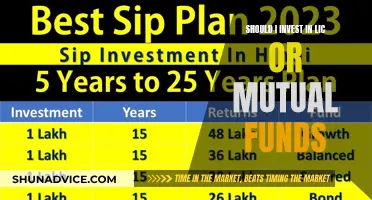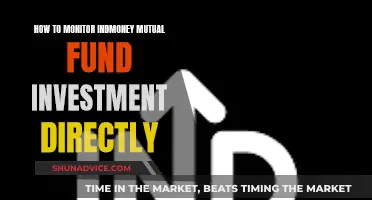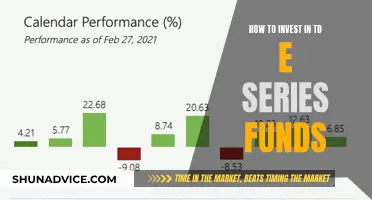
Investing in a managed fund can be a great way to diversify your portfolio and access a wide range of investments. Managed funds, also known as mutual funds, are a type of investment vehicle where money from many investors is pooled together and managed by professionals. By investing in a managed fund, you can benefit from their expertise and resources, making it easier to navigate the complex world of investing.
When you invest in a managed fund, you buy units in the fund, and the number of units you own depends on the amount you invest. The fund managers then use the pooled money to invest in various assets, such as shares, bonds, property, or cash. The type of assets they invest in depends on the fund's objectives and strategy.
There are two main types of managed funds: actively managed funds, where the manager actively selects stocks to try and outperform a benchmark, and passively managed funds, which aim to match a benchmark's performance rather than beat it.
Investing in managed funds offers several advantages, including diversification, professional management, and accessibility. However, it's important to consider the potential downsides, such as fees, the lack of guaranteed returns, and the reduced control over your investments.
Before investing in a managed fund, it's crucial to define your financial goals and risk tolerance, review the fund's Product Disclosure Statement, and monitor your investment's performance.
What You'll Learn

Define your goals and risk tolerance
Before investing in a managed fund, it is crucial to define your financial goals and risk tolerance. This involves understanding your investment objectives, risk comfort level, and financial circumstances. By doing so, you can make informed decisions about the types of managed funds that align with your goals and risk appetite.
Managed funds offer a diverse range of investment strategies, asset allocations, and fee structures. Some funds may focus on specific sectors, such as technology or healthcare, while others may target certain types of assets, like shares, bonds, or property. There are also funds tailored to different risk profiles, with options ranging from low-risk, steady-income funds to high-risk, high-reward funds.
When defining your financial goals, consider your short-term and long-term objectives. Are you saving for a specific purchase, such as a house or a child's education? Are you aiming for capital growth, or is stable income generation more important to you? Understanding your goals will help you choose funds that match your desired outcomes.
Risk tolerance, on the other hand, refers to the amount of risk you are comfortable taking on in your investments. It is influenced by factors such as your financial situation, investment horizon, and personal risk appetite. If you have a low-risk tolerance, you may prefer funds that invest in more stable assets, such as bonds or cash investments. On the other hand, if you have a higher-risk tolerance, you may be open to more aggressive investment strategies, including high-risk, high-reward assets like shares.
It is essential to remember that risk and return are typically correlated. Higher-risk investments may offer the potential for higher returns but also carry a greater possibility of loss. Lower-risk investments, while providing more stability, may have lower returns. Therefore, it is crucial to assess your risk tolerance honestly and choose funds that align with your comfort level.
Additionally, consider the fees associated with different managed funds. Actively managed funds, where the fund manager actively selects investments to outperform a benchmark, often come with higher fees. Passively managed funds, which aim to replicate a market index, usually have lower fees due to their less intensive management requirements. Understanding the fee structure of each fund will help you assess whether the potential returns justify the costs.
In conclusion, defining your financial goals and risk tolerance is a crucial first step when considering investing in managed funds. By understanding your objectives, risk comfort level, and financial circumstances, you can make informed decisions about the types of funds that align with your goals and risk appetite. This will help ensure that your investments are tailored to your needs and preferences, setting you up for a more successful investment journey.
Large-Value Mutual Funds: A Smart Investment Strategy
You may want to see also

Understand the types of managed funds
Managed funds pool together the money of individual investors to buy assets such as shares, bonds, property or cash. There are thousands of managed funds to choose from, and it's important to understand the different types of funds, their risks and returns, so you can choose a fund that meets your needs.
Single Asset Managed Funds
These funds invest in a single asset class, such as shares, property or bonds. Some examples include:
- Money market funds: These invest in short-term fixed-income securities, such as government bonds, treasury bills and certificates of deposit. They are generally considered safer but have lower potential returns.
- Fixed interest or bond funds: These funds invest in low-risk investments, including government bonds, bank bills or mortgage-backed securities.
- Property funds: These funds invest in residential, commercial or development property. They can be high risk, and you may not be able to withdraw your money at short notice.
- Share (equity) funds: These funds invest in listed companies and offer the potential for higher returns, but with higher risk.
Mixed Asset or Multi-Sector Managed Funds
These funds invest in a range of assets, typically with around 85% in shares and property, and the rest in cash or fixed interest. They aim to balance the goal of achieving higher returns with the risk of losing money.
Actively Managed Funds
In these funds, the manager actively selects the stocks based on their own convictions. Actively managed funds may attempt to outperform the overall market or a specific benchmark. While they offer more control, they often come with higher fees.
Passively Managed Funds
Passively managed funds, or index funds, aim to match the performance of a benchmark rather than beat it. They are typically lower cost and may have lower fees than actively managed funds. Exchange-traded funds (ETFs) are usually passively managed.
Alternative Investment Funds
These include hedge funds and funds that invest in private equity, derivatives and commodities. They can be high risk, and financial advice should be sought before investing.
Each type of managed fund has its own unique characteristics, risks and potential returns. It's essential to understand these aspects before investing and to ensure that the fund aligns with your investment goals and risk tolerance.
Pension Funds: Equities for Long-term Growth and Diversification
You may want to see also

Review the Product Disclosure Statement (PDS)
Before investing in a managed fund, it is crucial to review the Product Disclosure Statement (PDS). The PDS is a vital document that provides detailed information about the fund, enabling prospective investors to make informed decisions. It outlines the fund's strategy, risks, fees, and more.
The PDS offers valuable insights into the fund's investment strategy, including the types of assets it invests in, the level of diversification, and the overall approach to generating returns. Understanding the fund's strategy helps ensure that it aligns with your investment goals and risk tolerance.
Additionally, the PDS discloses the fees associated with the managed fund. These fees can vary significantly and impact your overall returns, so it is essential to know what you will be charged. Different funds have different fee structures, and understanding them beforehand is crucial. Some common fees include management fees, performance fees, and establishment fees.
The PDS also provides information about the fund's risks. All investments carry some level of risk, and it is important to understand the potential downsides of investing in the fund. The PDS will outline the specific risks associated with the fund's strategy, assets, and market exposure.
By reviewing the PDS, you can make a well-informed decision about investing in a particular managed fund. It provides transparency and helps you assess whether the fund aligns with your financial objectives, risk appetite, and investment preferences. Taking the time to thoroughly review the PDS is a crucial step in the investment process.
Invest HSA Funds: TD Ameritrade Guide
You may want to see also

Make the investment
Once you have decided on a managed fund that suits your goals and risk appetite, you can go ahead and make the investment. If you are using an online broker, you will need to open an account, search for the fund's ticker, decide how much you want to invest, and place your order. On the other hand, if you are investing directly with the fund manager, you will typically need to complete an application form and provide identification documents due to Know Your Customer (KYC) regulations.
Most managed funds require a minimum initial investment, which could be in the range of $500 to $10,000. It is important to note that when you invest in a managed fund, you are purchasing units in the fund rather than the assets directly. The number of units you own will depend on the amount you invest and the value of each unit at the time of purchase. The unit price will fluctuate with the market.
You can also make additional contributions to your investment over time. Many funds offer a regular savings plan, allowing you to purchase additional units at a lower average price through "dollar cost averaging". You may also have the option to reinvest any income earned from the fund back into your principal investment, which can compound your investment and lead to higher returns over time.
Remember, investing is typically a long-term journey, so it is important to monitor your investment's performance and view short-term fluctuations in that context.
Debt Funds: Where Does Your Money Go?
You may want to see also

Monitor your investment
Monitoring your investments is key to ensuring your financial plan stays on track. Here are some ways to monitor your managed fund investment:
Create a financial plan
A financial plan will help you determine how much risk you need to take to meet your financial goals. It should outline the types of investments and the allocation needed to meet your goals while staying within your risk tolerance.
Look at the whole picture
It is common to have investments spread over many accounts, including current and old employer plans, retirement accounts, and brokerage accounts. It is critical to review your investments as a total portfolio across all your accounts. Look at the overall allocation to determine if it aligns with your financial plan.
Establish benchmarks
Just as you need a financial plan to guide your investment decisions, you need a benchmark to evaluate your portfolio's performance. Establish a weighted, blended benchmark consistent with your target allocation. For example, if your allocation is 50% stocks and 50% bonds, your benchmark could be weighted accordingly.
Evaluate your individual holdings
Once you've determined that your overall allocation is in line with your financial plan, it's time to look at your individual holdings. Compare the performance of mutual funds and ETFs against market benchmarks and peer group measurements. For individual stocks, look at an appropriate market index.
Get professional help
If you feel uncomfortable monitoring your investments yourself, consider hiring a professional for a second opinion. Be clear about the type of help you need and establish expectations for the relationship.
Use online tools and apps
Several mobile investment apps and online portfolio trackers offer real-time information on your investments in one place. Some popular options include Empower, SigFig Wealth Management, Sharesight, and Yahoo Finance. These apps can sync with your existing accounts, measure performance against benchmarks, and provide retirement tracking and planning.
Review account statements and fund factsheets
Review your account statements and fund factsheets to understand how your investments are performing and the costs you're paying. Compare the performance against your goals and guidelines in your investment policy statement.
Consult disclosure documents
Securities regulators require mutual funds to file documents such as prospectuses, independent review committee reports, and management reports of fund performance. These documents can provide valuable information to assess a mutual fund's performance.
Stay informed
Follow stock market news and general economic news to understand the broader context affecting stock prices. Are we in a bull or bear market? What are the interest rates and inflation rates? How are currencies performing against each other? These factors can influence stock prices.
Regularly review and adjust
Regularly review your mutual fund investments to ascertain if they have performed as expected and if any restructuring is required. Funds also make mandatory public disclosures that provide insights into their performance.
Remember, investing is not a passive activity. Establish a routine, time frame, and process to review your holdings and make adjustments as needed to stay on course.
Choosing a Fund: Key Factors for Smart Investing
You may want to see also







